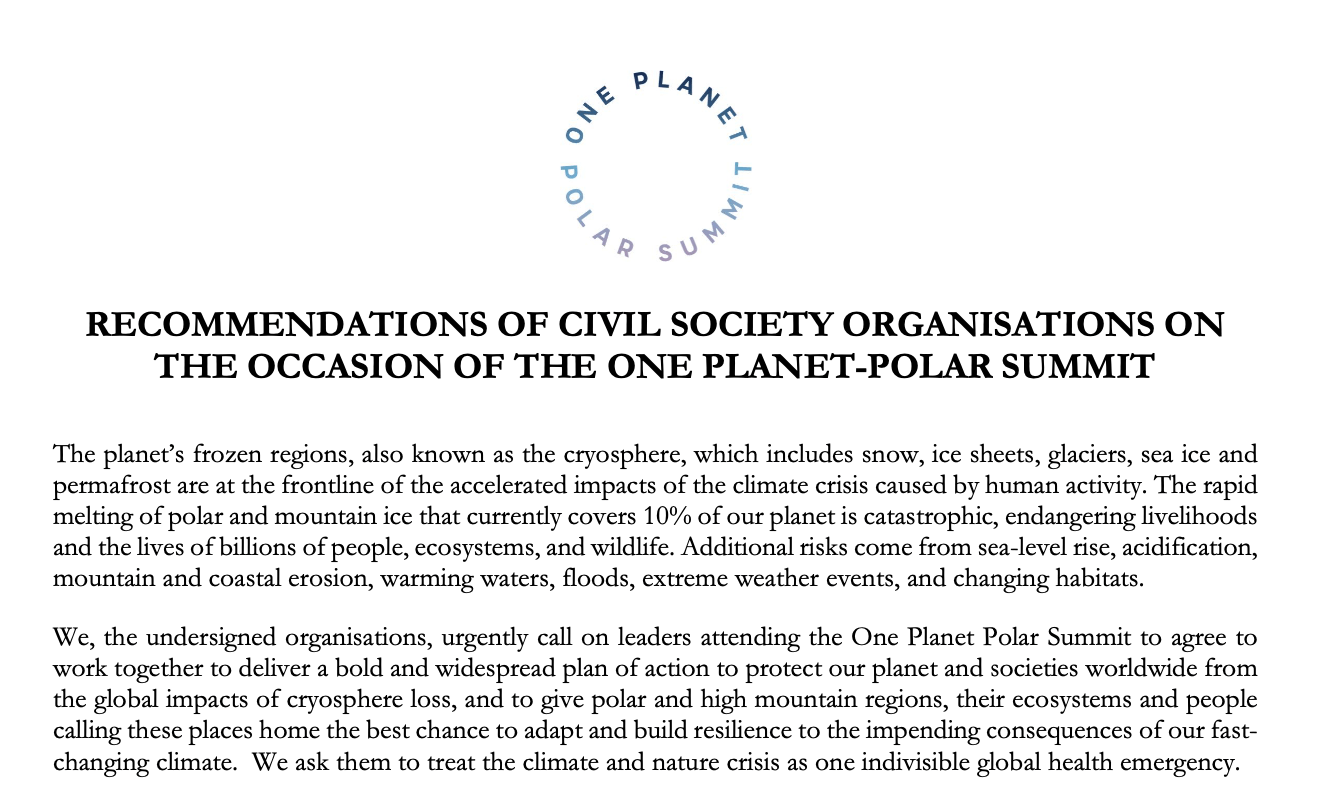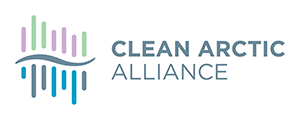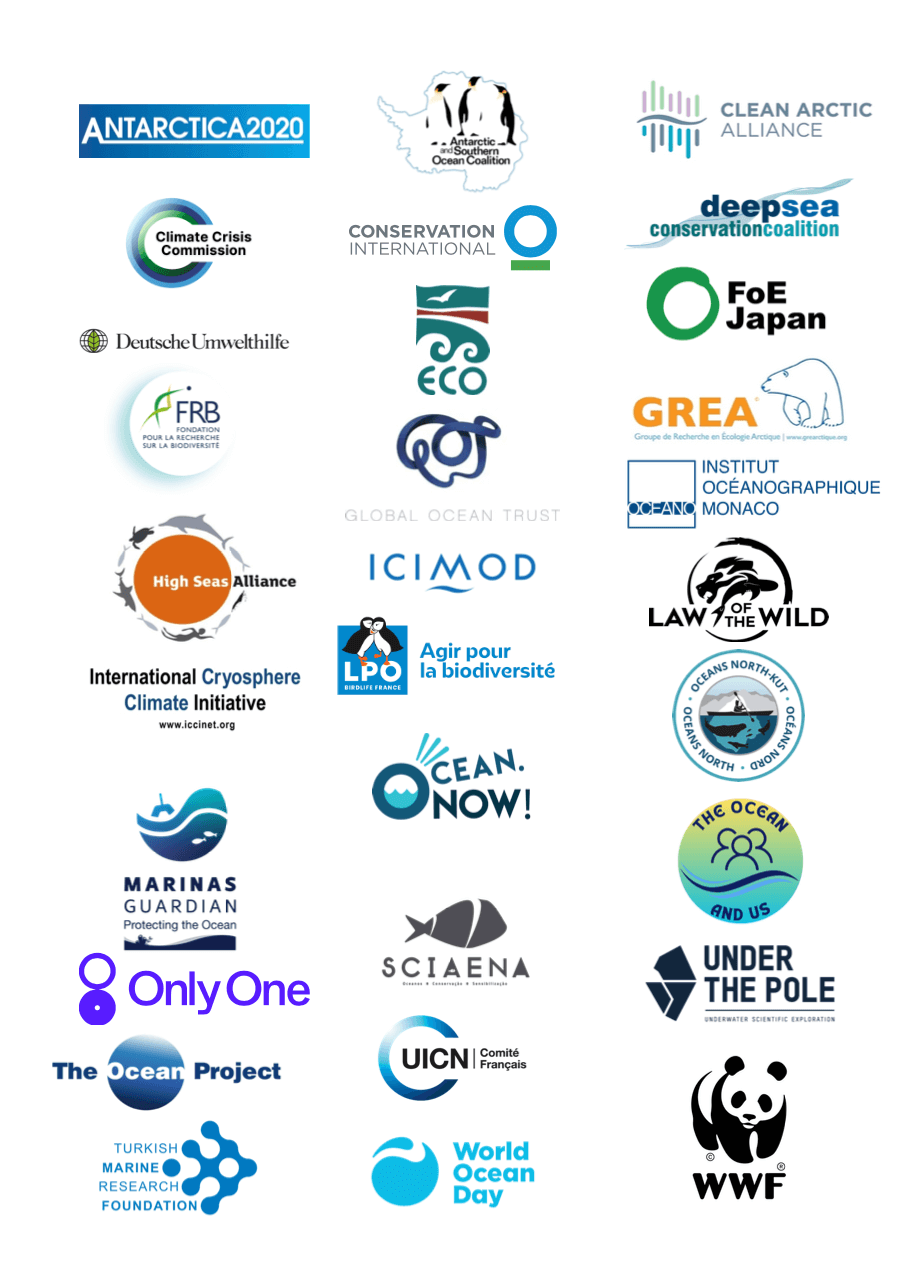
The planet’s frozen regions, also known as the cryosphere, which includes snow, ice sheets, glaciers, sea ice and permafrost are at the frontline of the accelerated impacts of the climate crisis caused by human activity. The rapid melting of polar and mountain ice that currently covers 10% of our planet is catastrophic, endangering livelihoods and the lives of billions of people, ecosystems, and wildlife. Additional risks come from sea-level rise, acidification, mountain and coastal erosion, warming waters, floods, extreme weather events, and changing habitats.
We, the undersigned organisations, urgently call on leaders attending the One Planet Polar Summit to agree to work together to deliver a bold and widespread plan of action to protect our planet and societies worldwide from the global impacts of cryosphere loss, and to give polar and high mountain regions, their ecosystems and people calling these places home the best chance to adapt and build resilience to the impending consequences of our fast- changing climate. We ask them to treat the climate and nature crisis as one indivisible global health emergency.
The resulting “Paris Call for Glaciers and Poles” needs to be effectively followed up by action. The most urgent priority is to translate political leadership from the One Planet Polar Summit to UNFCCC COP 28 in Dubai, including through this year’s historic opportunity for a course-correction of greenhouse gas (GHG) emissions under the Global Stocktake Process. Second, the Declaration needs to have an effective follow up mechanism with identified leads to accelerate delivery and implementation of the commitments so that the UN Ocean Conference in France in 2025 translates these commitments into actual ocean-related mechanisms and actions. We commit to supporting these leads in accelerating delivery efforts towards impact.
We regret that, despite good efforts, it was not possible to ensure the desired level of engagement of Indigenous Peoples in the Summit and its preparations. We strongly encourage countries and their political leaders to engage Indigenous Peoples at all stages of the Summit’s follow up and in the planning for future events, from UNFCCC COPs to the UN Ocean Conference and beyond, and in all efforts to deliver a bold and widespread action to protect our planet and societies worldwide from the global impacts of cryosphere loss.
Together, we call on leaders to:
1. Accelerate implementation of agreed commitments:
- Accelerate national and international efforts to reduce the emission of greenhouse gases and short-lived climate pollutants, in line with commitments to the Paris Agreement to limit global warming under 1.5°C so that the world is assured a life-sustaining climate system.
- Pursue efforts to lower the concentration of carbon dioxide in the atmosphere to 350 parts per million, a level deemed safe for the integrity of the cryosphere.
- Urgently work to implement the goals and targets of the Kunming-Montreal Global Biodiversity Framework to deliver on biodiversity commitments which will have complementary mitigation and adaptation benefits while minimising the impact of climate change and ocean acidification on biodiversity.
- Effectively follow up on the IPCC’s Special Report on the Ocean and Cryosphere in a Changing Climate conclusions, notably on the establishment of marine protected areas in the polar regions as an important adaptation response to the climate crisis. This will also be a key contribution to achieving the global target of protecting at least 30% of the ocean by 2030.
- Uphold and strengthen the protection and conservation objectives, principles and goals of the AntarcticTreaty and the Antarctic Treaty System and combat all activities which could undermine these.
- Accelerate the ratification process of the High Seas Treaty, and support countries that may need capacity building and support to ensure its early entry into force and full implementation.
- Strengthen oversight and enforcement mechanisms to ensure ships comply with the Polar Code regulations, focusing on safety and environmental protection.
- Allocate substantial funding fors cientific research, including on climate change impacts, in polar regions and promote international collaboration in these efforts as key to sustainable development.
2. Strengthen their commitments to protect and conserve the cryosphere:
- Recognise that without stringent and emergency-scale action to limit global warming to 1.5°C per the above, no actions to protect and conserve the cryosphere will prove sufficient.
- Continuetoadvocateatthehighestpoliticallevelwithinternationalpartnerstoensuretheswiftestablishment of a representative circumpolar network of marine and terrestrial protected areas both in the Arctic and in Antarctica, based on the best available science and Indigenous knowledge. Advocate likewise for a high mountain preservation network.
- Establish a global moratorium on deep-sea mining within the International Seabed Authority. Ban deep-sea mining in areas within national jurisdiction.
- Extend indefinitely the moratorium on commercial fishing in the Central Arctic Ocean.
- Implement stricter regulations for shipping, fishing, and tourism activities in the polar regions, minimising their ecological impact.
- Recognise, respect, uphold and support Indigenous rights and livelihoods in the Arctic and in the high mountain areas; integrate Indigenous knowledge into decision-making processes.
- Mobilise the international community to raise awareness of glacier preservation needs and advocate for collaborative initiatives.
- Address the underfunded development of sustainable cryosphere infrastructure by substantially scaling up and sustaining public and private investments and by facilitating and enhancing access to funding mechanisms, focusing on enabling scalable pilot actions with the overarching goal of building resilient societies to changes in the cryosphere.
3. Remain accountable to the civil society:
- Establish a transparent monitoring mechanism to track progress on the implementation of the commitments of the “Paris Call for Glaciers and Poles” to ensure that the declaration moves from words to action, including through, but not limited to, an ambitious course-correction of GHG emissions at the UNFCCC COP28 and a successful and impactful UN Ocean Conference in 2025.
- Ensure that scientific advice is appropriately reflected in policy negotiations and management actions.
- Appoint specific individuals or organisations as leads for driving commitment implementation, ensuring they have the necessary resources and authority while respecting the competences of relevant regional, subregional and sectoral bodies.
- Encourage civil society organisations to actively participate in monitoring and advocating for commitment fulfilment, fostering collaboration among governments, Indigenous Peoples, civil society, and the private sector.
4. Engage meaningfully with Indigenous Peoples:
- It is time to plan NOW for participation of Indigenous Peoples and a followup to this Summit towards the UNFCCC COPs and the 2025 UN Ocean Conference. Lead time and meaningful inclusion, in the spirit of applying the United Nations Declaration on the Rights of Indigenous Peoples, could ensure that upcoming relevant international forums are not faced with a lack of Indigenous engagement.
ANNEX
DETAILED RECOMMENDATIONS FROM CIVIL SOCIETY ORGANISATIONS TO
DECISION-MAKERS ON THE OCCASION OF THE ONE PLANET-POLAR SUMMIT
A Global and overarching actions
A.1 Significantly and urgently reduce greenhouse gas and short-lived climate pollutant emissions.
- A.1.1 Bearing in mind the global commitment under the Paris Agreement to holding the increase in the global average temperature to well below 2°C above pre-industrial levels and pursuing efforts to limit the temperature increase to 1.5°C, as well as the Glasgow Climate Pact resolve to pursue efforts to limit the temperature increase to 1.5°C, commit to accelerate decarbonisation as quickly as possible and strive for zero global emissions by 2050 at the latest aiming to lower carbon dioxide concentration in the atmosphere to 350 parts per million (ppm). Only a lowering of CO2 concentration and curbing emissions of short-lived climate pollutants (methane and black carbon) can prevent dangerous levels of polar ocean acidification, irreversible ice loss, permafrost thaw, sea-level rise, loss of mountain water resources and an increase in cryosphere-related mountain hazards.
- A.1.2 Confront the contribution of emissions from fossil fuels for energy, from deforestation and from degradation to the global warming that is driving the cryosphere crisis by banning all fossil fuel subsidies, setting aggressive phase-out targets for fossil fuel use, and establishing exacting mitigation performance standards for the fossil fuel sector geared towards zero emissions, including from legacy exploration and production sites.
A.2 Facilitate and fund scientific research to understand and monitor changes in the global cryosphere and accelerating impacts and risks.
- A.2.1 Invest in collaborative, participatory, gender-responsive, inter-, and transdisciplinary cryosphere research, including projects such as networked in-situ mountain observatories, Digital Twin, Ice Memory, etc., taking fully into account the knowledge of Indigenous Peoples, and local communities, in the Arctic and high mountain areas.
- A.2.2 Enable and promote active knowledge exchange among scientists and other knowledge holders, as well as open sharing of the findings according to the FAIR (Findable Accessible, Interoperable, and Reusable) principles. Promote sharing of findings with the media to make the general public aware of polar and high mountain areas and increase appreciation and compassion for these regions and the challenges they face.
- A.2.3 Foster and support specific education initiatives at all levels, curriculum-based programmes at secondary and university level, and networks among educational institutions, with the goal of preparing early career professionals to meet the needs of users, stakeholders and policymakers in polar and mountainous regions facing evolving challenges, and thus foster broad climate literacy.
A.3 Ratify and accelerate implementation of instruments and frameworks agreed under international environmental law.
- A.3.1 Swiftly ratify the new UN Agreement under the UN Convention on the Law of the Sea on the conservation and sustainable use of marine biological diversity of areas beyond national jurisdiction (the High Seas Treaty) to secure the 60 ratifications needed to enter into force, and take initial steps for its effective implementation thereafter, with the goal of achieving this before the 2025 UN Ocean Conference.
- A.3.2 Accelerate effective implementation of the Kunming-Montreal Global Biodiversity Framework, including, but not limited to, the commitment to protect at least 30 percent of terrestrial and inland water areas and 30 percent of marine and coastal areas by 2030.
- A.3.3 Strengthen oversight and enforcement mechanisms to ensure ships comply with the Polar Code regulations, focusing on safety and environmental protection. Strengthen and adapt the Code to the evolving conditions in polar shipping to maintain the highest environmental standards.
- A.3.4 Establish a moratorium on deep sea mining within the International Seabed Authority.
-
A.4 Provide all necessary support, including through capacity-building and relevant international and national financial mechanisms, to ensure successful and ambitious international programmes on the cryosphere, such as the UN-declared International Year of Glaciers’ Preservation in 2025, the Fifth International Polar Year in 2032-2033, the Antarctica InSync programme and a United Nations decade on cryosphere science.
-
A.5 Actively contribute to capacity-building and the implementation of financial reforms in accordance with multilateral environmental agreements, such as the UNFCCC and the Kunming-Montreal Global Biodiversity Framework, at both the international and domestic levels, to support cryosphere science and the co-production and transfer of knowledge.
B Antarctica
B.1 Increase protection through establishing a representative network of protected areas on land and sea as a key contribution to achieving the 30×30 target by:
- B.1.1 Developing a long-term circumpolar vision to protect Antarctica to be presented at the 2025 UN Ocean Conference and by securing, in the short-term, the designation of four large effective Marine Protected Areas (MPAs) in the East Antarctic, Weddell Sea (Phases 1 and 2) and Antarctic Peninsula, currently under discussion at CCAMLR, and ensure that the work of governing bodies is not politicised and undermined.
- B.1.2 Designating marine protected areas in the Subantarctic, such as the Del Caño rise and East Kerguelen MPAs, in order to create an effective and interconnected MPAs network for the Southern Ocean.
- B.1.3 Securing the protection, under the CCAMLR “Special Areas for Scientific Study”, of newly-exposed marine areas following the calving or collapse of glaciers, so that those environments can be studied and protected.
B.2 Resource Antarctic and Southern Ocean science and research through increased funding and development of collaborative initiatives, as well as through increased transparency within all bodies governing this region.
- B.2.1 Create a pooled fund for research, monitoring and governance of protected areas and adaptation responses to build resilience and promote further protection in the region.
- B.2.2 Create robust, accessible, and collaborative research and monitoring plans to determine the effectiveness of a MPA and its associated management actions are in conserving biodiversity and improving a food web’s structure and functioning over time.
- B.2.3 Urgently promote and develop all other available tools to protect biodiversity in the polar regions, including the IUCN Red List of species, the IUCN Red List of Ecosystems, Important Marine Mammal Areas, Key Biodiversity Areas, and the adoption of ecosystem-based and precautionary approaches.
B.3 Significantly reduce pressure of human and industrial activities in Antarctica, such as fishing, shipping, tourism, and pollution drivers in the region including:
- B.3.1 Resetting the relation between conservation and sustainable use within the CCAMLR, through strengthening fisheries management measures, based on the ecosystem approach and precautionary principle.
- B.3.2 Maintaining a highly precautionary approach for the management of krill fisheries within CCAMLR. Any revision to these precautionary catch limits has to take into account the already observed and predicted changes in the marine environment and biodiversity of the Southern Ocean, including climate change related impacts.
- B.3.3 Accounting for carbon emissions in the Antarctic, including through aviation, shipping, fishing, tourism, and scientific research, and investing in sustainable new infrastructures, with the goal of cutting Antarctic emissions in half by 2030 and reaching net zero carbon emissions as near as 2040 as possible.
- B.3.4 Adopting measures to rapidly reduce black carbon emissions from all vessels in the Southern Ocean by 2030 and set out a strategy to decarbonise all vessels visiting the region by 2040.
- B.3.5 Instituting precautionary measures to regulate and slow down Antarctic tourism and implementing the decision reached at the 45th Antarctic Treaty Consultative Meeting to start negotiations on a dedicated framework for tourism with a view to minimising its impacts, taking into consideration the Glasgow Declaration on Climate Action in Tourism.
- B.3.6 Removing all pollution arising from all Antarctic bases, including legacy pollution from historic, decommissioned bases.
C Arctic
C.1 Support the exercising of Indigenous rights in the management of Arctic land and waters, for example through Indigenous leadership and participation in relevant decision-making processes, including the use of Indigenous Knowledge and the context-specific co-production of new knowledge for climate resilient development.
- C.1.1 Promote advancement of the recognition of rights of circumpolar Indigenous Peoples, as stewards of the Arctic from time immemorial, inspired by Indigenous-driven governance solutions in various parts of the Arctic and the “Circumpolar Inuit Declaration on Sovereignty in the Arctic” from the Inuit Circumpolar Council.
- C.1.2 Support leadership and participation of Indigenous Peoples coastal communities and other local communities in monitoring, restoration and other scientific programmes related to understanding and responding to the impacts of ecosystem change, climate change and industrial activities.
- C.1.3 Develop appropriate protocols with Indigenous Peoples to ensure Indigenous Knowledge is justly included in any assessment related to Arctic ecosystems and climate.
C.2 Increase protection of Arctic waters, and Indigenous land, including by:
- C.2.1 Prioritising protection of Arctic ecosystems and biodiversity and identifying and establishing an ecologically representative, well connected and equitably governed network of protected and conserved areas both on land and on the sea. Advancing the protection of the Last Ice Area and Pikialasorsuaq (Northwater Polynya) as areas particularly significant for the Arctic sea-ice ecosystem and biodiversity and cultures linked thereto.
- C.2.2 Aligning domestic and international approaches and standards of conservation, as well as Indigenous Peoples approaches, in designating and managing conserved and protected areas to accomplish
conservation and indigenous food security goals, including Indigenous Peoples Conserved and Protected Areas across the Arctic.
C.2.3 Continuing an effective moratorium on commercial fishing under the Central Arctic Ocean Fisheries Agreement (CAOFA) in perpetuity and ensuring that any exploratory fishing authorised under the CAOFA follows strict conservation measures protecting the Central Arctic Ocean ecosystems. Using the CAOFA’s precautionary approach and governance mechanism to advance ecosystem based and ocean-wide governance in the Central Arctic Ocean to address cumulative risks from climate change and economic development.
C.3 Significantly reduce pressure of human and industrial activities in the Arctic, including by:
- C.3.1 Committing to no new oil and gas development and prohibiting deep-sea mining exploration for commercial purposes and exploitation in waters within and beyond national jurisdiction.
- C.3.2 Reducing the threat of airborne pollutants to Arctic climate, biodiversity, and people. This includes decarbonising Arctic shipping through continuous reductions in carbon dioxide, methane, and nitrous oxide emissions and adopting regulations to urgently eliminate black carbon emissions from shipping in and near the Arctic before 2030 and move towards zero emission shipping by 2040.
- C.3.3 Establishing low-impact, connected, effectively managed, and monitored shipping routes, based on science and Indigenous knowledge, that minimise impacts on marine mammal populations, including during their migrations, through underwater noise and impacts on food security.
- C.3.4 Banning the use of heavy fuel oil and any dumping from marine activities, and establishing Arctic standards on sewage, grey water, and scrubber wastewater.
- C.3.5 Reducing the threat of introducing invasive alien and non-native species to the Arctic by developing and implementing common measures for early detection and reporting, identifying, and blocking pathways of introduction, and sharing best practices and techniques for monitoring, eradication, and control. This includes supporting international efforts currently underway, for example those of the International Maritime Organization to effectively treat ballast water to clean and treat ship hulls and drilling rigs.
- C.3.6 Establishing robust regulatory frameworks that ensure tourism operations respect Indigenous Peoples’ rights, avoid areas where biodiversity may be impacted, reduce speed limits, limit air and water pollution, phase out use of fossil fuels and follow low-impact routes.
- C.3.7 Build partnerships with the private sector to limit industrial impacts in the Arctic Ocean. This includes proactively addressing potential future shipping routes with a view towards maintaining the CAO as a “quiet ocean”, preserving compactness and durability of remaining sea ice, and seeking voluntary commitment to limit new shipping routes as ice recedes.
- C.3.8 Ensuring integration of Arctic Council Working Groups’ recommendations that reflect transboundary and cross-cultural solutions to emerging problems in the Arctic. For example, the PAME Working Groups Arctic Marine Shipping Assessment and subsequent recommendations should continue to be implemented to mitigate emerging threats from vessel traffic in the Arctic.
- C.3.9 Banning bottom trawling in all Arctic coastal waters.
- C.3.10 Reducing stressors on migratory species, such as habitat degradation and overharvesting in wintering and staging areas, along flyways, and other migration routes, while including of Indigenous peoples in all harvester programs and monitoring efforts.
C.4 Invest significantly in collaborative, participatory, cross-disciplinary, intersectional and gender-responsive research. This includes research on the impacts of sea ice change on biodiversity,
global climate, and adjacent Indigenous communities and improving our capacity to monitor environmental changes relevant to people and wildlife.
C.5 Integrate hitherto fragmented and sector-based Arctic Ocean governance with the overall aim of ensuring a participatory, adaptive, and anticipatory ecosystem-based approach to ocean management in the Arctic, including through spatial planning, as a key contribution to region- specific climate-resilient development.
D Glaciers, snow, and permafrost
-
D.1 Mobilise the international community on pursuing a framework for a sustainable global cryosphere data and information system, following the FAIR Guiding Principles for scientific data management and stewardship, and on developing existing knowledge hubs and data centres.
-
D.2 Invest significantly in collaborative, participatory, cross-disciplinary, intersectional and gender-responsive initiatives that are focused on risk management and adaptation in high mountain areas.
- D.2.1 Effective planning for “peak water” management, as well as declining water resources in river basins, especially in rivers originating from the Hindu Kush Himalaya, the Andes, and other high mountain areas around the world, providing especially important seasonal water supplies for local as well as downstream communities.
- D.2.2 Proactively and systematically monitor, catalogue, record, and analyse cryosphere-related hazards (e.g., Glacier Lake Outburst Floods, snow and ice-rock avalanches, permafrost/mountain slope collapse), and their cumulative downstream impacts. Incorporate these hazards in the Early Warnings for All programmes, as well as in the development of anticipatory social protection programmes.
- D.2.3 Support adaptation through integrated, multiscalar, and transboundary monitoring, as well as through the implementation of purpose-driven data exchange across institutions, to enable adaptive water management approaches.
- D.2.4 Improve monitoring networks to ensure long-term capacity to properly assess downstream impacts and develop effective response and adaptation measures.
- D.2.5 Recognise the cultural importance of the cryosphere and ensure Indigenous Peoples and local communities are proactively involved in any risk management and adaptation initiative.
- D.2.6 Co-design and implement early warning and disaster risk reduction measures, aimed in particular at local and downstream communities. This includes fostering collaboration with and amongst space agencies focusing on a coordinated approach, to enhancing the monitoring of the cryosphere in high- mountain and polar areas and supporting relevant applications and services.
-
D.3 Support international initiatives aiming at preserving the knowledge recorded in the glaciers and permafrost. This includes the Ice Memory Project, which aims to collect and preserve the planetary memory and cultural heritage recorded in the glaciers before they disappear forever. Address by increased scientific effort the mapping, recording and preservation of the history of hominids and their contemporary network of life, to address their evolution linked to the cryosphere.
-
D.4 Commit to participate proactively in international events aimed at raising awareness on glaciers, such as the 2025 International Year of Glaciers’ Preservation and the World Glacier Days on 21 March.


